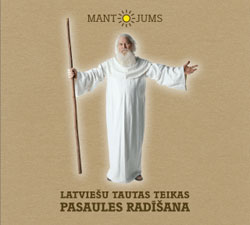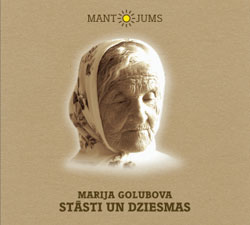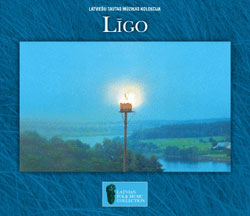
Latviešu tautas teikas: Pasaules radīšana (Latvian Folk Tales: The Creation of the World) is a collection of 24 tales read in standard Latvian by a professional reader. Leons Krivāns reads clearly and with the right amount of expression—pleasant to listen to, but not too overdone. Kaspars Tobis provides bits of background music (mostly meditative synthesizer) and sound effects, but it still probably goes without saying that this compact disc is primarily for those listeners who understand the Latvian language.
The recording is part of the “Mantojums” series produced by UPE Recording Co. of Rīga. The first three recordings in the series were released in December.
As the title suggests, most of the tales are about the creation of various parts of the world: how the land was formed; how the hills and roads, the stars and the Big Dipper, the rainbow, the big river, and the dew were created. Most are clever explanations and many involve God and the foolish devil, but a couple of the tales are kind of silly. There are three tales about fire, and even a tale about solar and lunar eclipses.
The tales were selected from the collections of the well-known Latvian folk tale collectors Ansis Lerhis-Puškaitis (1859-1903) and Pēteris Šmits (1869-1938).
Lerhis-Puškaitis began already as a child to write down the stories and tales he heard from classmates in his dormitory, and by the end of his life he had recorded around 6,000 folk tales and fairy tales. He always tried to keep the tales true to the speakers dialect and speech idiosyncrasies.
Šmits was a linguist who eventually devoted more and more of his time to the collection of Latvian folklore. He published collections of folk beliefs, folk songs, traditional designs, and mythology in addition to a 15-volume collection of folk tales and fairy tales.
I recommend Latviešu tautas teikas: Pasaules radīšana to anyone who enjoys listening to folk tales. It’s great for children, but great for adults, too.
The other two recordings in the “Mantojums” series are Marija Golubova: Stāsti un dziesmas, featuring Marija Golubova telling stories and singing songs from her long life, and Putnu un zvēru valoda, with stories about the language of birds and animals told by Pēteris Liepiņš.
Details
Latviešu tautas teikas: Pasaules radīšana
Mantojums
UPE Recording Co., 2003
UPE CD 054





